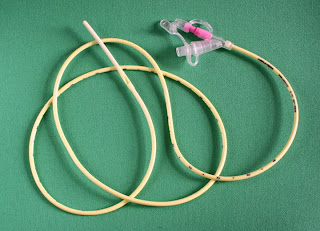Non-oral Nutrition
Definitions
|
Enteral feeding
|
Delivery of
nutrients and hydration into the gastrointestinal tract.
|
|
Nasogastric feeding
(NG)
|
Placement of a tube
for nutrient ingestion in the nose.
|
|
Percutaneous
endoscopic gastrostomy (PEG)
|
Endoscopic placement
of a tube through the abdominal wall directly into the stomach.
|
|
Jejunostomy
(J-tube)/ PEJ
|
Surgical/ endoscopic
placement of a tube for nutrient ingestion through the abdominal wall
directly into the jejunum.
|
|
Cervical
esophagoscopy/pharyngoscopy
|
Surgical placement
of a tube through the lateral pharyngeal wall directly into the upper
oesophagus.
|
|
Total parenteral
feeding (TPN)
|
Administration of
nutrients through a central vein.
|
|
Intravenous
hydration
|
Administration of
fluids for hydration only.
|
Enteral Feeding
|
Indications
|
Contraindications
|
|
· 1 to 2 weeks of no nutrient intake (unable to
orally ingest nutrients/ unsafe oral feeding).
· Can be temporary/permanent.
· Placing tubes into the stomach allows for
digestion at a controlled rate (rather than into the small intestine).
|
· Mechanical obstructions.
· Severe vomiting/ upper GI bleeding
· If the patient is not able to ingest
nutrients via the GI tract.
|
Nasogastric Feeding (NG-tube)
Indications
· Indicated when enteral feeding is required for
a short period of time i.e. recovery of swallow function is expected.
· Typically used for under 30 days.
Contra-indications
· Nasal obstruction
· Confused/agitated patients – may not cooperate/
tolerate the discomfort of tube insertion as placement can be quiet traumatic.
Placement of the
NG-tube
· Patients are asked to swallow the tube as it is
pushed through the nose into the stomach.
Complications
· GI and mechanical complications can occur.
· Vomiting, cramping, diarrhea, risk of
self-extubation
· Risk of aspiration if the tube is
inappropriately placed.
Gastrostomy Feeding
(e.g. PEG)
Surgical opening into
the stomach to allow the placement of a feeding tube. Gastrostomy is the most
prevalent type of long term enteral feeding.
Indications
· Patients who cannot/ will not orally eat.
· If the resumption of oral feeding is likely to
take longer than 30 days.
· May be used for patirents with dysphagia.
· PEG = non surgical (a fibreoptic endoscope is
used).
Contra-indications
· Overall medical condition of the patient i.e.
are they medically stable.
· Patients with severe irreversible illnesses,
especially the elderly.
Jejunostomy
· For patients who have a previous history of
tube-feeding aspiration pneumonia, reflux esophagitis, or when there is a
reason the stomach cannot be used.
· Often used with patient swho have severe
reflux.
· Diarrhea is a common complication due to the
patients difficulty in regulating absorption via the intestine.
Intravenous Nutrition
· Used when patients have a non-functioning GI
tract.
Complications of
Enteral feeding
|
Aspiration
|
1. Aspirtion of oral secretions – tube feeding
may not eliminate the primary source of pulmonary aspiration in patients with
severe dysphagia.
2. Reflux aspiration – increased reflux may
occur with NG feeding since the tube passes through the pharynx and may lead
to transient relaxation of the LES.
3. Body position aspiration – patients need to
be at 45 degrees when tube fed if they are in a supine position they are at
risk of tracheal aspiration.
|
|
Enteral feeding
regimens
|
1. Bolus feeding – administration of formula
intermittently throughout the day using a syringe, pump or gravity. Syringe
feeding = rapid + can be associated with GI reflux and vomiting. It does however ‘normalise’ the
digestive system.
2. Continuous feeding – speed of feeding is
controlled with a pump/ gravity. Roubenoff (1992) recommend slow continuous
drip feeding to reduce the risk of aspiration regardless of placement.
Feeding is slow. But nutrient absorption is enhanced. A gradual progression
from continuous to bolus feeding is recommended to normalise the bodies
consumption of nutrients.
|
|
Diarrhoea
|
· Common complication of enteral feeding
|
|
Medications
|
· Drug absorption and metabolism may be
altered/ interrupted during tube feeding.
|
Deciding on non-oral
feeding
1.
Comprehensive
formal/ informal dysphagia assessment – gain information on the patients
medical condition, physiology and personal attributes.
2.
Patient’s
preferences/ capacity – does the patient have capacity to make a decision
regarding feeding options.
3.
Prognosis
for recovery
Legal/ Ethical issues
· Quille (1992) tube feeding is not viewed as
‘basic, humane care that must always be provided’
· If a patient pulls out a feeding tube, it is a
non-verbal indicator that they do not give consent for the tube.
· PEG tubes are less likely than NG-tubes to be
pulled out.
How to progress form non-oral to oral nutrition
Groher and Mckaig (1995)
· Suggest that bolus feeding continues for 3-5
days before oral trials are attempted, to allow the stomach time to ‘stretch’
and reinitiate the hunger cycle.
· They recommend that one meal be introduced
orally for 1 week, with more meals added as the patient is able to tolerate
oral feeding.
· Tube feedings are adjusted depending on the
patients oral intake.
· The introduction of oral food requires
consultation with the medical team (nurse, physician, dietician, pharmacist) to
monitor health, nutritional status and any significant changes.
· Criteria necessary for increased oral
nutrition= indicators of nutritional status (fluid+calorific intake), and
overall health status, such as strength, endurance and respiratory condition.

No comments:
Post a Comment